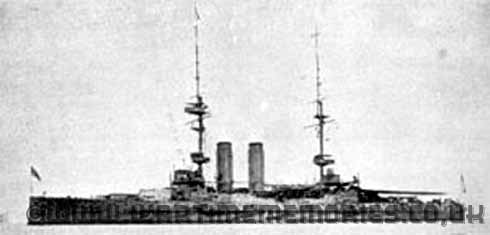HMS Albemarle 
HMS Albemarle
HMS Albemarle was a pre-dreadnought Duncan-class battleship of the Royal Navy, named after George Monck, 1st Duke of Albemarle. She was amongst the fastest battleships of her time when she was commissioned, but she was superseded by the new dreadnoughts which began entering service from 1906. Despite this, she served with the Grand Fleet on the Northern Patrol during the early stages of World War I. She was dispatched to Murmansk in Russia for guard and icebreaking duties for most of 1916. On her return to England, she underwent a refit and was in reserve for the remainder of the war. Decommissioned in April 1919, she was scrapped in 1920.
HMS Albemarle was laid down on 1 January 1900 at Chatham Dockyard,[5] and launched on 5 March 1901, when Lady Kennedy, wife of Admiral Sir William Kennedy, Commander-in-Chief of the Nore, performed the christening.[6] She was completed in November 1903.
World War I
When World War I began in August 1914, plans originally called for Albemarle and battleships Agamemnon, Cornwallis, Duncan, Exmouth, Russell, and Vengeance to form the 6th Battle Squadron and serve in the Channel Fleet, where it was to patrol the English Channel and cover the movement of the British Expeditionary Force to France. However, plans also existed for the 6th Battle Squadron to be assigned to the Grand Fleet, and, when the war began, the Commander-in-Chief, Grand Fleet, Admiral Sir John Jellicoe, requested that Albemarle and her four surviving sister ships of the Duncan class (Cornwallis, Duncan, Exmouth, and Russell) be assigned to the 3rd Battle Squadron in the Grand Fleet for patrol duties to make up for the Grand Fleet's shortage of cruisers. Accordingly, the 6th Battle Squadron was abolished temporarily, and Albemarle joined the 3rd Battle Squadron at Scapa Flow on 8 August 1914, and worked with Grand Fleet cruisers on the Northern Patrol.
Albemarle and her four Duncan-class sisters, as well as the battleships of the King Edward VII class, temporarily were transferred to the Channel Fleet on 2 November 1914 to reinforce that fleet in the face of German Navy activity in the Channel Fleet's area. On 13 November 1914, the King Edward VII-class ships returned to the Grand Fleet, but Albemarle and the other Duncans stayed in the Channel Fleet, where they reconstituted the 6th Battle Squadron on 14 November 1914. This squadron was given a mission of bombarding German submarine bases on the coast of Belgium, and was based at Portland, although it transferred to Dover immediately on 14 November 1914. However, due a lack of antisubmarine defenses at Dover, the squadron returned to Portland on 19 November 1914. The 6th Battle Squadron returned to Dover in December 1914, then transferred to Sheerness on 30 December 1914 to relieve the 5th Battle Squadron there in guarding against a German invasion of the United Kingdom.
Between January and May 1915, the 6th Battle Squadron was dispersed. Albemarle left the squadron in April 1915 and rejoined the 3rd Battle Squadron in the Grand Fleet. She underwent a refit at Chatham Dockyard in October 1915.
In November 1915, Albemarle was ordered to move to the Mediterranean with a division of the 3rd Battle Squadron that also included the battleships Hibernia (the flagship), Zealandia, and Russell. The ships left Scapa Flow on 6 November 1915, but encountered extremely heavy weather that night in the Pentland Firth. Albemarle, heavily loaded with spare ammunition, suffered severe damage early on 7 November when two large waves struck her in rapid succession, wrecking her forebridge and chart house, shifting the roof of her conning tower, and flooding her forward main gun turret, mess decks, and flats. An officer and rating were washed overboard and lost, another rating was killed, and three officers and 16 ratings suffered serious injuries; two of the injured ratings later died. In an 8th November 1915 letter to First Sea Lord Admiral Henry B. Jackson, Commander-in-Chief of the Grand Fleet Admiral John R. Jellicoe described what had happened, saying that Albemarle had been making 16 knots when water from the two waves had risen as high as the bottom of her lower foretop, filling the foretop with water, sweeping her forward deck clear and smashing the forebridge, most of which was found in pieces on her upper deck. Accompanied by Zealandia, Hibernia assisted her in proceeding for repairs to Scapa Flow, where she arrived later on 7 November and transferred 24 injured ratings on stretchers and three officers to the hospital ship Plassey for further treatment.
When her repairs were complete in December 1915, Albemarle was ordered to rejoin the Grand Fleet. She thus became the only Duncan-class ship (other than Montagu, which had been wrecked before the war) with no wartime Mediterranean service.
In January 1916, Albemarle was detached from the Grand Fleet to serve in North Russia at Murmansk as guard ship and as an icebreaker in the approaches to Arkhangelsk. At Murmansk, she also served as flagship of Senior Naval Officer, Murmansk.
Decommissioning
Albemarle returned to the United Kingdom in September 1916, paying off at Portsmouth to provide crews for antisubmarine vessels. She began a refit at Liverpool in October 1916, and upon its completion in March 1917 she went into reserve at Devonport Dockyard; her main-deck casemate 6-inch (152-mm) guns were removed and replaced with four 6-inch (152-mm) guns on her battery deck between September 1916 and May 1917.
Post-World War I
Albemarle was in reserve until April 1919, used as an overflow accommodation ship for the naval barracks at Devonport, and was attached to the Gunnery School in 1919.
Disposal
Albemarle was placed on the disposal list in April 1919 and on the sale list in August 1919. She was sold for scrapping to Cohen Shipbeaking Company on 19 November 1919 and arrived at Swansea for scrapping in April 1920.
John Doran
5th Nov 1914 Reorganisation
14th Nov 1914 Bad Weather
If you can provide any additional information, please add it here.






